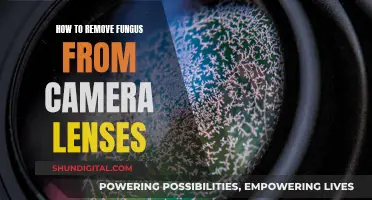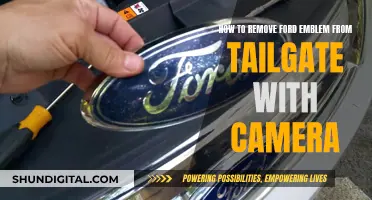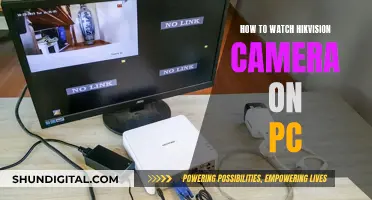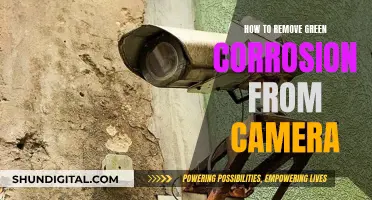
How to Locate TV Cameras
Modern smart TVs are getting thinner and thinner, but that doesn't mean they can't have hidden cameras installed. These cameras are usually placed in strategic positions, such as the upper edges and bezels of the TV, and are often retractable or very small, making them hard to spot. However, there are several ways to detect these cameras and make sure your privacy is protected.
One simple method is to turn off the lights and look for reflective surfaces or blinking red or green lights, which may indicate the position of a camera lens. You can also use a flashlight or the torch on your smartphone to look for reflections that might indicate the presence of a camera. Another way to use your smartphone is to download a hidden camera detector app, which can help you locate cameras quickly and easily.
If you have a smart TV, you can also check your Wi-Fi network to see if any unknown devices are connected, as most hidden cameras are connected to Wi-Fi. You can then remove any suspicious devices from your network.
If you are still unable to locate a hidden camera but have a strong suspicion that there is one, you can purchase a professional RF (radio frequency) signal detector, which will alert you to the presence of a camera by beeping when it detects a signal.
| Characteristics | Values |
|---|---|
| Camera location | Cameras are often found at the upper edges and on the bezels of smart TVs. Cameras on Samsung TVs are found at the center of the device, while those on LG TVs are retractable. |
| Camera identification | The camera lens is typically a small circle with a tiny red lens. |
| Camera functionality | Cameras are used for video chats, facial recognition, and tracking user activities such as viewing habits. |
| Disabling the camera | This can be done by navigating to the Settings menu, scrolling to Privacy Options, checking for advertising, tapping "Limit Ad Tracking", scrolling to Camera Accessibility, and toggling off the feature. |
What You'll Learn

Using a flashlight to locate the camera lens
If you suspect that there's a hidden camera in your vicinity, one way to confirm your suspicions is by using a flashlight. Here's a step-by-step guide on how to do it:
Step 1: Turn Off the Lights
Start by turning off all the lights in the room. This will make it easier to spot any reflective surfaces that could be camera lenses.
Step 2: Use a Flashlight
Turn on a flashlight and slowly scan it around the room. You can use a regular flashlight or the flashlight on your phone. Pay close attention to any items that seem out of place, such as pictures hung too high or decorations in odd locations.
Step 3: Look for Reflective Surfaces
As you scan the room with your flashlight, keep an eye out for reflective surfaces where they shouldn't be. Most of a hidden camera will be concealed, but the camera lens must be visible for it to function effectively. So, a reflective surface in an unexpected place could be a telltale sign of a hidden camera.
Step 4: Check for Items That Seem Out of Place
While scanning the room, also look for items that seem out of place. For example, a mirror or decoration at a weird height or in an odd location could indicate a hidden camera.
Step 5: Check for Two-Way Mirrors
If you come across any mirrors, shine your flashlight on them at different angles and observe closely. Two-way mirrors are often used to conceal cameras, so this is an important step.
Step 6: Cover the Camera and Contact Authorities
If you do find a hidden camera, it's important to cover the lens and contact local law enforcement immediately. Do not attempt to remove or disable the camera, as this could destroy valuable evidence. Instead, document the camera's location by taking photos and videos, and let the authorities handle the rest.
Do Principles Spy on Teachers via Cameras?
You may want to see also

Scanning the room for reflective surfaces
When scanning a room for reflective surfaces that could be camera lenses, it's important to be aware that the camera lens must always be visible for the camera to be effective. This means that you can spot a hidden camera by looking for its lens.
- Turn off all the lights in the room and use a flashlight or your phone's flashlight to scan the room. Look for reflective surfaces where they shouldn't be.
- Look for items that seem out of place. Mirrors and decorations, such as pictures or paintings, are often placed at a certain height and in specific locations. If you see something at a weird height or in an odd location, there may be a hidden camera embedded.
- Check to see if a mirror is two-way. The general rule of thumb is that if there's a gap between your fingertip and its reflection, it's a real mirror. If it looks like your finger and its reflection are touching tip-to-tip, it could be a two-way mirror or masking a hidden camera.
- Use your cell phone's front camera to look for infrared light. Turn off the lights and scan the room through your phone's camera. Your phone may be able to pick up small, red dots of infrared light coming from a hidden camera.
- Use a radiofrequency (RF) detector to scan the room for radio feedback. An RF detector will alert you with a beeping sound when it detects a hidden camera, making it one of the most accurate ways to find a hidden camera.
Stream Unifi Cameras on Apple TV: Easy Steps
You may want to see also

Checking for blinking lights in a dark room
If you're concerned about the presence of TV cameras, one of the simplest methods to detect them is to turn off the lights in the room and use a flashlight to scan the area. Most hidden cameras feature blinking red or green LEDs that are visible in low-light conditions. By creating a dark environment and carefully examining your surroundings, you can spot these telltale signs of camera activity.
- Ensure the room is as dark as possible. Draw the curtains, turn off all lights, and eliminate any sources of illumination.
- Look for blinking red or green LEDs. These lights are often subtle, so pay close attention to your surroundings.
- Use a flashlight to further inspect the area. Shine the flashlight around the room, focusing on areas that could potentially house a camera.
- Observe any reflective light from camera lenses. As you move the flashlight, keep an eye out for surfaces that reflect light. This could indicate the presence of a camera lens.
Additionally, you can utilise smartphone apps designed for camera detection. These apps typically scan for unidentified devices within Bluetooth or Wi-Fi range and can be helpful in detecting hidden cameras that use wireless connections. However, it is important to only download such apps from trusted sources like Google Play or the Apple App Store to avoid malware.
Galaxy Watch 4: Camera Expectations Unveiled
You may want to see also

Using a mobile phone to detect interference
It is possible to use a mobile phone to detect interference from TV cameras. There are several methods you can use, depending on the type of camera you suspect is monitoring you, and the type of phone you have.
Detecting Infrared (IR) Cameras
Many cameras that see in low lighting use IR light, which the human eye can't detect. However, IR lights often appear as purple, blue, or white lights on your phone's camera. To detect these, turn off the lights and scan the room with your phone. You should be able to see any IR lights emitted by hidden cameras.
Using a Camera App
You can use your phone's camera app to detect IR lights. Simply open the app and scan the room for unusual lights or reflections. You can also use your phone's flashlight to shine a light on any hidden camera lenses, which will reflect the light back.
Using a TV Remote
You can also use a TV remote (or any remote that uses IR) to test whether your phone can detect IR. Open your camera app, make sure the room is dark, and aim your phone at the remote. Then, turn on the remote or press some buttons. You should see a small light, which will probably be purple, blue, or white. If you don't see this with your rear-facing camera, try with your front-facing camera.
Using an App
There are many third-party apps available that can help you detect hidden cameras. These include:
- Hidden Camera Detector (Android)
- Hidden Spy Camera Detector (iOS)
- Glint Finder (Android)
- DontSpy 2 (iOS)
- Network Scanner (Android)
These apps work in different ways, such as by detecting electromagnetic (EM) fields, or reflections from camera lenses.
Understanding the Vibrating Camera Symbol on Your Apple Watch
You may want to see also

Using a professional RF detector
Choosing the Right RF Detector:
Select a professional-grade RF detector suitable for your specific needs and budget. The market offers a range of options, from affordable models to more advanced devices with higher sensitivity and range.
Prepare the Area:
To ensure accurate detection and minimise false positives, it's crucial to reduce interference from other electronic devices. Turn off and unplug gadgets that emit radio signals, such as kitchen appliances, baby monitors, routers, modems, and televisions.
Methodical Scanning:
With the RF detector activated, start scanning the room slowly and systematically. Cover all areas where a hidden camera could be installed, including less obvious spots like smoke detectors, light fixtures, and air vents. Pay extra attention to areas that offer a clear view of the room.
Listen for Alerts:
Most RF detectors emit an auditory signal, such as a beep, when they detect a radio frequency. This signal often becomes more intense as you get closer to the source. Listen carefully for these alerts and investigate any spots where the detector reacts more strongly.
Double-Check Suspicious Areas:
If the RF detector signals a potential camera, carefully inspect the area. Sometimes, a detailed physical examination is necessary to confirm the presence of a hidden device.
Continuous Monitoring:
In places with a higher risk of surveillance, such as vacation rentals or hotel rooms, it is advisable to use the RF detector regularly for ongoing peace of mind.
What to Do if You Find a Hidden Camera:
If you discover a hidden camera, it's essential to handle the situation carefully. Do not touch or move the camera, as law enforcement may use fingerprints or other forensic evidence to identify the perpetrator. Take clear photographs or videos of the camera, its location, and the surrounding area. Contact local authorities and the accommodation provider (if applicable) to report the incident.
ProctorU: Exam Surveillance Through Your Camera Lens
You may want to see also
Frequently asked questions
If your TV has facial recognition or supports video calls, it has a hidden camera somewhere. You can also check by turning off the lights and looking for a small circle with a tiny red lens, which is usually found at the upper edges and on the bezels of the TV.
Disabling the camera function depends on the manufacturer. However, the following steps will disable the camera function on most TV brands: navigate to the Settings menu, check for advertising, tap "Limit Ad Tracking", scroll to Camera Accessibility, and toggle off the feature.
You can use a professional RF (radio frequency) signal detector to locate spy cameras. Alternatively, you can use your mobile phone. Make a call and take your phone near the suspected area. If there is a hidden camera, it will distort the signal and make a wheezing sound.
If you find a hidden camera, contact law enforcement immediately. Cover the camera and avoid touching or removing it, as the location could be a clue for officers.







